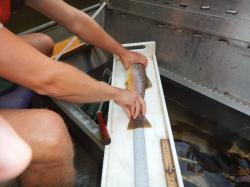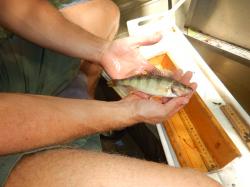 VDGIF Region II Complementary Work Force [CWF] Volunteer Al Kittredge posted this blog entry below with great photos detailing an ElectroFishing Suirvey trip on the Smith River in Henry County in late August. CWF volunteers are a great asset to the Agency assisting staff in a variety of field and office activities. Al's reporting and photos are very informative on the hard work of surveying rivers to gather data to improve management of the Commonwealth's fisheries.
VDGIF Region II Complementary Work Force [CWF] Volunteer Al Kittredge posted this blog entry below with great photos detailing an ElectroFishing Suirvey trip on the Smith River in Henry County in late August. CWF volunteers are a great asset to the Agency assisting staff in a variety of field and office activities. Al's reporting and photos are very informative on the hard work of surveying rivers to gather data to improve management of the Commonwealth's fisheries.
From Al Kittredge outdoor blog…
What's a fellow to do when he needs a fishing fix, but his favorite trout stream is running water too fast for safe wading? I solved that dilemma this past Thursday (8-25-16) by linking up with VDGIF Region II biologists who brought their wide beamed 18 foot Jon Boat equipped with a jet propulsion engine down for electronic sampling of the wider sections of the Smith River near the Doe Run boat ramp in lower Martinsville. A short shaft and no prop allows the wide bottom boat to operate in less then a foot of water. We were able to motor to where the water forms it's first significant riffle just downstream of the Hill Memorial Baptist Church.
Those electronic probes and long nets are a great way to fish. You still have to be quick and there is always the challenge of avoiding a jab to your partner's body or face with the long handle as you swing around to deposit the fish into the open live well.
VDGIF biologist George Palmer zig-zagged the boat from bank to bank, swinging the probes through all likely looking spots. Each run is timed with most going 10-15 minutes before the live well starts to cry "enough already – process these fish before they run out of oxygen"
Each fish is looked over for general health, measured, weighed and then released. This data is later entered into a computer program which helps biologists assess the overall heath of the fishery.
We collected some nice fish.
A few yellow peach, bass and lots of suckers were also seen. The suckers were so numerous we did not bother to scoop them up. Numerous brown trout exceeding the 19-20 inch mark were collected. All of these fish fall within the 10-24 inch protected slot which means if you are lucky enough to catch them they must be released.
Numerous brown trout exceeding the 19-20 inch mark were collected. All of these fish fall within the 10-24 inch protected slot which means if you are lucky enough to catch them they must be released.
Big fish of the day measured an honest 26 inches. This fish was the largest I have see in several years helping VDGIF sample the Smith River. He didn't get that large eating midges.
Boats back on the trailer and off they go to another stream, river, lake or watershed. Such is the life of a fisheries biologist – and to think they get paid to do this!! Today was a easy day but they are not all like this – some days are sweltering hot, others cold and rainy. Some involve slipping and sliding in waders while pulling a heavy generator laden barge or hoisting a backpack electronic devise on your back. Most biologists have advanced degrees in biology or other science based curriculum. They could probably make more money working in private industry but they all love what they do and wouldn't have it any other way.
VDGIF Region II Complementary Work Force [CWF] Volunteer Al Kittredge posted this blog entry with great photos detailing an ElectroFishing surveying trip on the Smith River in Henry County in late August. CWF volunteers are a great asset to the Agency assisting staff in a variety of field and office activities. Al's reporting and photos are very informative on the hard work of surveying rivers to gather data to improve management of the Commonwealth's fisheries.
Copyright © 2013-2025 WesternBass.com ®


 Advertising
Advertising